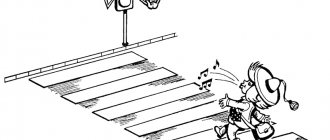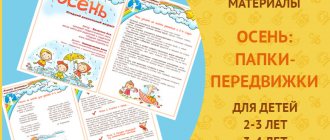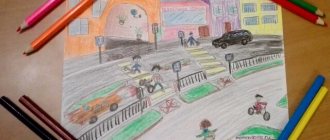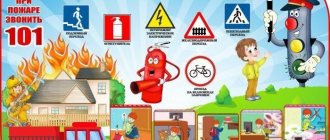Folder for parents “Road Rules”
IN
Summer has come - a wonderful time for vacations and school holidays, swimming, long walks and playing in the fresh air. Unfortunately, it is in the summer that the percentage of child injuries as a result of road traffic accidents increases. To prevent accidents on the road, it is necessary to conduct traffic safety classes in kindergartens and schools. And, of course, conversations between parents and their children about the rules of behavior on the roadway are of great importance.
H
A common mistake made in such cases is the wrong approach to starting a conversation. Talking to children about the dangers of the road in an overly stern tone is ineffective. In this case, the child will not be interested in the conversation and, as a result, will learn only a small part of the information. It is much more effective to talk to your child calmly, choosing a moment when he is not busy with anything and his attention is at your disposal. Before explaining, indicate the importance and seriousness of the conversation, let the baby feel his importance. His attention near the road should be a request, not a demand. He must understand that they are worried about him and that he is in danger. This motivation is much stronger than fear of punishment or reproaches.
.
Another common mistake parents make is acting on the principle “you can do it with me.” If you show your child by your own example how to run to red, be sure that when left alone, he will try to repeat this trick.
Recommendations for teaching children traffic rules:
When leaving home:
— If there is possible movement at the entrance of the house, immediately pay attention to the child to see if there is any approaching traffic.
— If there are vehicles at the entrance or trees growing, stop your movement and look around to see if there is any danger.
When driving on the sidewalk:
— Keep to the right.
— The adult must be on the side of the roadway.
— If the sidewalk is next to the road, parents should hold the child’s hand.
—
Teach your child to carefully watch cars leaving the yard while walking along the sidewalk.
When preparing to cross the road:
—Stop and look at the roadway.
— Develop your child’s observation of the road.
- Emphasize your movements: turning your head to scan the road. A stop to inspect the road, a stop to let cars pass.
— Teach your child to peer into the distance and distinguish approaching cars.
— Do not stand with your child on the edge of the sidewalk.
— Draw the child’s attention to the vehicle preparing to turn, talk about the turn signal signals on cars.
— Show how the vehicle stops at the crossing, how it moves by inertia.
Unusual author's folder-moving according to traffic rules
Larisa Bukina
Unusual author's folder-moving according to traffic rules
One of the important areas in the work of a preschool teacher is to familiarize children with the rules of the road. We also involve parents in this work, who are direct examples for their children, acting as road users.
Mobile folders , in which you can place any information on issues of interest, serve us as direct assistants in this matter.
I think that a mobile folder should contain not only useful information, but also be an object of decoration for the reception area, unusual and eye-catching.
And I made a folder that I now want to bring to your attention.
For this folder I needed : cardboard (the size of the cardboard sheet should be larger than A4)
; fleece fabric of different colors, “Moment” glue - transparent gel. I love using fleece in crafts; it's a bright, soft, fluffy fabric that doesn't require any special finishing.
I covered the cardboard sheets with white fleece. Separately, I prepared road signs, also made of fleece on a cardboard base. Leaflets with information are inserted into file staplers, glued to the base with double-sided tape.
On the first sheet I placed a traffic light, each color of which has its own emotion (the sketch of the traffic light was taken from the Internet)
. There should have been another traffic light there initially, but I came up with another use for it and you can see it below.
The traffic light and all signs are attached to the folder using adhesive tape. This technique makes the folder multifunctional . It can be used as a folder on traffic rules and on other topics. Just change the traffic signs for other badges, emblems, drawings made using the same technique.
At the back, so that the folder stayed straight and did not fall, I strengthened it in this way. It may not be very beautiful, but it is reliable. And it’s not visible from the other side.
For now, in my second junior group, this folder is in the reception area , but in the senior group we will place it in the traffic rules corner. Here you can post information for children.
We also have a Traffic Light in our group, which helps children learn the rules of the road. (I wrote about him above)
I also took the sketch from the Internet, but it turned out so cute, and it would be a pity if it stood in the reception area. Therefore, now he “lives” in the group. and helps us in our work.
In addition to the travel folder , using fleece, I made unusual , non-existent traffic signs to participate in the city competition “We are for road safety.”
Folder “Traffic rules - interesting facts for children”
Who is this passenger, pedestrian, driver?
Let's try to determine who it is - a passenger, a pedestrian and a driver. When you go out into the street, you can see a lot of people walking or driving, but it’s quite difficult to understand who is who.
A pedestrian
- this is any person who goes outside. It doesn’t matter why or why this person went out onto the street, he still immediately becomes a pedestrian. He is called a pedestrian because he walks along the road and does not drive a car.
Passenger
- this is any person who rides in a car. It is important to remember here that the driver (the person driving the car) will not be considered a passenger. People who travel on a tram, bus, trolleybus or just get into a car cease to be pedestrians and immediately become passengers.
Driver
- This is the person who is behind the wheel of the car and makes it move. Drivers are also people who ride a bicycle or motorcycle.
It doesn’t matter who you are as a pedestrian, driver or passenger, the most important thing you need to do is follow the traffic rules in order to be safe and protect the people around you.
How they appeared
Traffic Laws
A long time ago, when there were no cars, people moved along the roads on foot, on horseback or in a cart. In those ancient times, there were no traffic rules. People walked and rode horses as they pleased, and often there were clashes between people and horses, and between horses. Another problem was that the city streets were not designed for heavy traffic and were very narrow.
Many historians believe that the founder of traffic rules is Julius Caesar. He was the emperor of the Roman Empire. During his reign, he tried to streamline and simplify traffic on the streets of Rome. These rules were introduced about 2000 years ago.
In Russia, the first traffic rules were established according to royal decrees. The first mention of such decrees dates back to the 17th century. The rules of those times consisted of several lines and told how to behave on the roads.
After the first self-propelled carts appeared, around the 18th century, rules were established for them. The problem was that such cars were very slow and therefore the rules, for example in England, required a person with red flags to walk ahead of the self-propelled carriage and warn pedestrians about the danger of getting under the wheels.
Since the massive introduction of regulations, each country has had its own regulations and standards for road traffic, which has been a big problem for travelers. At an international conference in 1909, a decision was made on an international standard for the rules. Also at this conference, the first road signs in history were introduced.
TRAFFIC LIGHT
A traffic light is a device for regulating traffic. The world's first traffic light appeared in England; it stood in the center of London, and was controlled by a man. This first device appeared about 140 years ago and was not similar to the modern one. It consisted of an arrow, which a special person raised and lowered, letting everyone know when to go and when to stop.
The first traffic light with lamps and powered by electricity appeared in 1914 in the USA and had only 2 colors - red and green. This traffic light was controlled by a person who kept track of the time. The traffic light switching from red to green and back was accompanied by a warning whistle. Later, a three-color traffic light (yellow signal) was invented, which was replaced by a whistle.
We looked at the history of the traffic light a little, now let's figure out how it works. In a modern city you cannot do without a traffic light. Without it, it is impossible to cross the street or cross an intersection by car. There will be many accidents on the roads and all this is only due to the fact that there will be no traffic lights. A traffic light tells road users when to drive and when to stand and let other cars and pedestrians pass.
The choice of colors for traffic lights is not accidental.
Red is the color of danger, clearly visible in any weather, and it prohibits driving or crossing the road.
Green is a very different color from red, and you can never confuse the two colors; it allows you to drive or cross the road.
Yellow - the color warns drivers and pedestrians about the change of traffic light signal to another and encourages them to be as attentive and careful as possible.
There are also special traffic lights for pedestrians. There is no yellow light in them, and on the lamp itself there are pictures of a green and a red man who show what to do: walk or stand.



